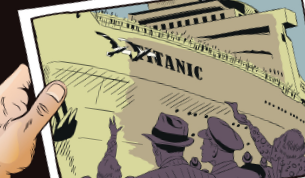THE STORY OF THE TITANIC
The Titanic, which was introduced as the ‘unsinkable’ and ‘most luxurious’ ship of its time, was a British passenger ship that sank on April 15, 1912, on its first voyage. Around 1,500 of the estimated 2,240 passengers and crew died in the sinking, and since then the disaster has become the topic of many books and films.
The surviving passengers and crew gave different descriptions of the disaster, but it is clear that many human errors played a part in the tragedy. Let’s look at some of the things that went wrong.
On the night of Sunday, April 14, 1912 the temperature was near freezing and the ocean was completely calm. One survivor, 2nd Officer Charles Lightoller, later wrote, “the sea was like glass.” The ship’s course had been changed by the captain, but other than this, he saw no reason to slow down. Bruce Ismay, who was the owner of the ship, was also on board and had instructed the captain to speed up in order to break the record for a transatlantic voyage. The captain agreed, but perhaps if he had known of the messages the ship had received in the radio room, he would have acted differently. According to a ship ahead called the Mesaba, lots of large icebergs were in the area. These messages did not reach him. When the alarm was finally raised the crew acted very quickly but it was already too late to save the ship. Within twenty minutes of the collision, the ship had flooded, so the captain ordered the lifeboats to be prepared, filled with women and children, and lowered into the water. This didn’t go well. Even if the evacuation had been better organized, there wouldn’t have been enough boats to hold everybody. Meanwhile, the crew were sending SOS messages. Several ships responded, but they were too far away. The closest ship to respond was the Carpathia, which arrived in about four hours. It was too late to save everybody. Many people accused Bruce Ismay of acting irresponsibly by requiring The Titanic to sail at such speed in spite of the danger.
That night only 712 people were rescued by the Carpathia, while 1,496 perished. If the lifeboats had been filled to capacity, the 1,178 people could have been saved. If there had been enough lifeboats, maybe everybody could have been saved. If the crew of the Titanic had taken better precautions of their own, the disaster may not even have happened in the first place.

